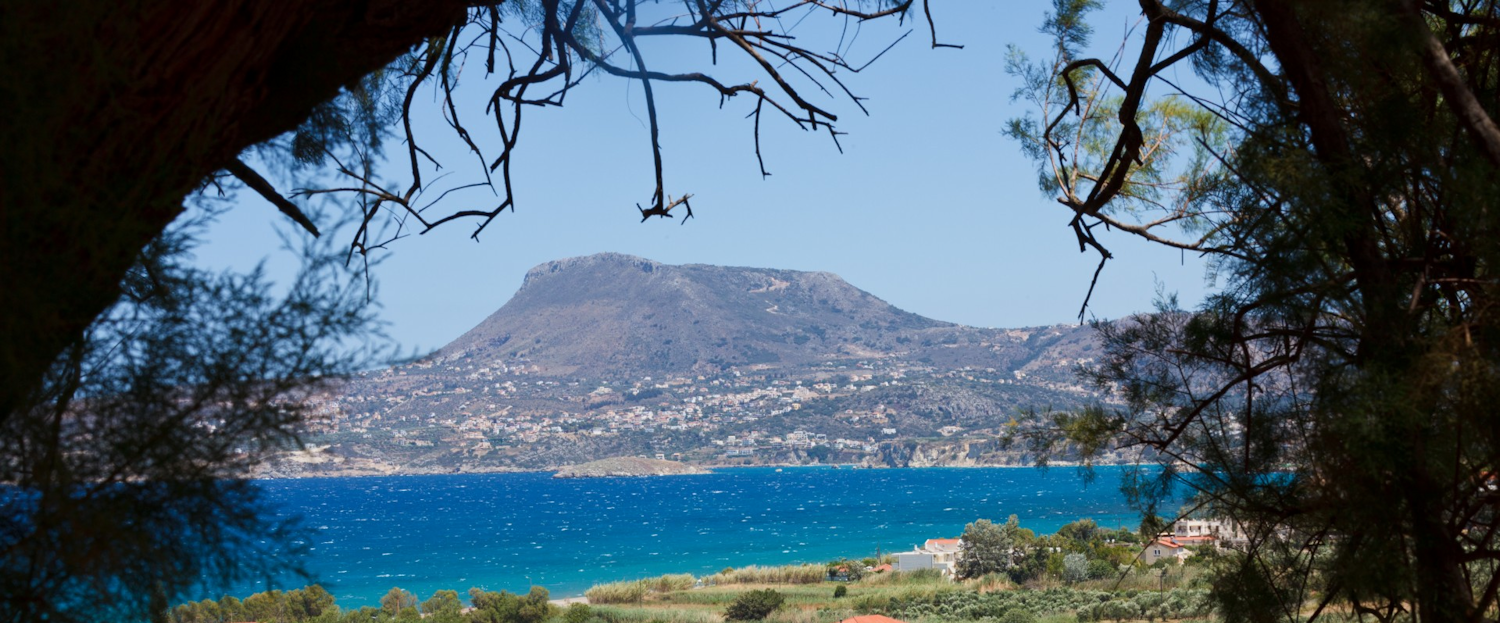Mountains, Gorges and Caves
Harsh mountains rising out of the sea
Crete is dominated by its spectacular mountains. More than 50% of Crete is mountainous and even relatively small distances can take hours to traverse. There are three major massifs: 'Lefka Ori' or the White Mountains of the west, Psiloritis in central Crete and the Dikti Mountains to the east. In addition a number of smaller mountain areas such as Kedros, Asterousia and Thripti.
Mount Psiloritis which is visible from Villa Talea is the highest mountain on Crete peaking at 2456 meters. The highest summit of the White Mountains is 2452 m and the Dikti and Thripti mountains reach 2148 meters and 1476 meters. In between the high ranges there are lower mountains and hills, valleys and plains. In the mountains there are over 3000 caves and caverns, many of which are still unexplored.
Others like the Melidhóni Cave nearby Villa Talea have been known and used for religious purposes for thousands of years. Crete has a number of mountain plateaus and over one hundred gorges ('pharangia') including the Samaria Gorge. With a length of 18 km it is the longest gorge in Europe. However, some of the shorter gorges are no less spectacular. A wonderful scenic drive if from Villa Talea you're heading for the south coast and Móni Prevéli goes via the Kourtaliótiko Gorge.
Mountains
Psiloritis
Also known under the name of Mount Ida, Idha, Ídhi, Idi or Ita. These are all variations on an old word for forest or wooded and probably alludes to Crete's reputation in antiquity as an island with very much forest. But the word can also be pre-Greek in origin and have to do with mother goddess. Psiloritis is derived from 'psilos' (high) and "oros" (mountain). Psiloritis covers large parts of central Crete. It is now a nature reserve and is home to some of Crete's rare animal and plant species.
Lefka Ori
Although the White Mountains are over 100 kilometers away, they can still be seen from our holiday home. The mountains are also called Madares in the Cretan dialect. It means 'bald' or 'without vegetation'. Both names allude to the white limestone peaks of the mountains.
In these mountains, which covers the western part of Crete, are some of the most inaccessible, rugged areas in Crete. Therefore they have been hiding place for rebels during both the Venetian and Ottoman periods and later during the German occupation.
In the White Mountains lies one of Europe's longest gorges, the Samaria gorge, which is an important nature reserve.
Dikti
The third largest massif in Crete is named after one of the Minoan gods that have been included in the later classical Greek mythology. Britomartis was the Minoan goddess of hunting and mountains. She was later named Diktynna and hence the name Dikti mountains.
Selekano and DiktiThe Dikti Mountains are located in eastern Crete, where they form a semicircle around the Selakano valley. Large parts of the mountains are covered by forest. Mainly pine (Pinus brutia), Kermes oak (Quercus coccifera) and cypress (Cupressus sempervirens). The mountains are also called Lassithiotika Ori after the famous Lassithi valley, situated near the mountains.
Gorges
Caves
There are more than 6.000 caves in Greece. And more than half of them are to be found on Crete. Many of them have been used as places of worship for thousands of years. Archaeologists have found votive gifts, figurines and other artifacts from Crete's rich past in the caves.
Others are even now fully or partially unexplored. And still today new, previously unknown caves are found. In some of the caves paleontologists have found remains from Crete's prehistory. Skeletal remains of dwarf elephants, hippos and others of Crete's prehistoric animals.
Many of the caves - including those listed below - can be visited.
Cave of Agia Paraskevi
The cave lies about 22 km from Heraklion. It was a place of worship in ancient times, but also during the Christian era.
Dikteon Andron (Psychro) Cave
This is according to Greek mythology the birthplace of Zeus. It lies about 2 km west of Agios Nicholaos. Some very important archaeological finds have been done here. You can walk the path to the cave on foot or rent a donkey from the locals.
Cave of Eileithyia
This cave lies 1 km south of Amnissos. It was used for cult rituals from the Neolithic up to the 5th century BCE. The cave has its name from the goddess Eileithyia, the goddess of childbirth, to whom it was sacred.
Gerani Cave
From this cave prehistoric animals as well as archaeological artefacts have been found. Finds can be seen in the Rethimnon Archaeological Museum.
Ideon Andron Cave
This famous cave lies 20 km south of the village Anogia, between the Nida Plateau and the peak of Mount Psiloritis. According to the ancient myths, this was the cave where Rhea hid the baby Zeus from his farther Kronos. Objects from the cave like statues and bronze shields are on display in the Heraklion Archaeological Museum.
Kamares Cave
This cave lies near the village of Kamares (4 hour walk from the village). It was a sacred place in Minoan times, possibly dedicated to the goddess Eilethyia. A distinct style of pottery has been named after the finds from this cave.Kamares vases, now on display in the Archaeological Museum of Heraklion were found here.
Melidoni Cave
3 km from the village of Melidoni and about 5 km from our holiday house. The cave was a place of worship during the Neolithic, Minoan and Archaic periods.
Sfentoni Cave
No cave on Crete has more stalactites and stalagmites than this natural wonder of a cave. It is situated in the Psiloritis mountains at an altitude of 800 m 1 km from the village of Zoniana.

